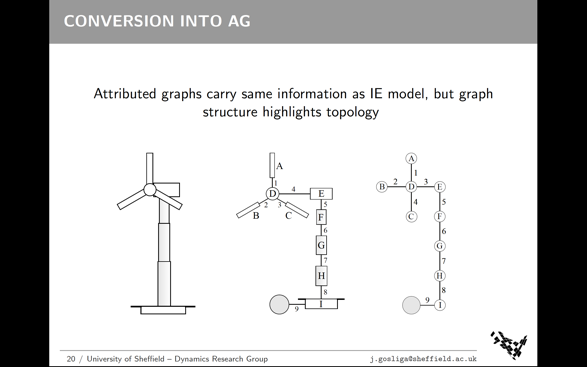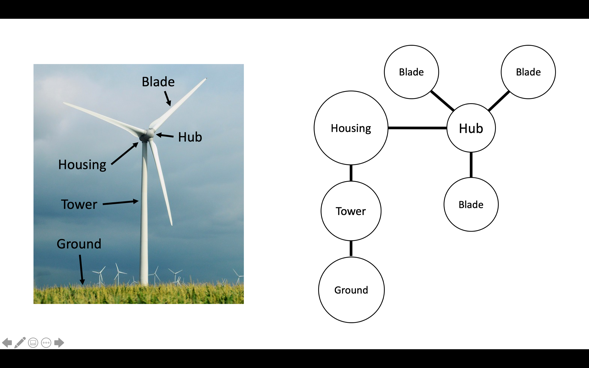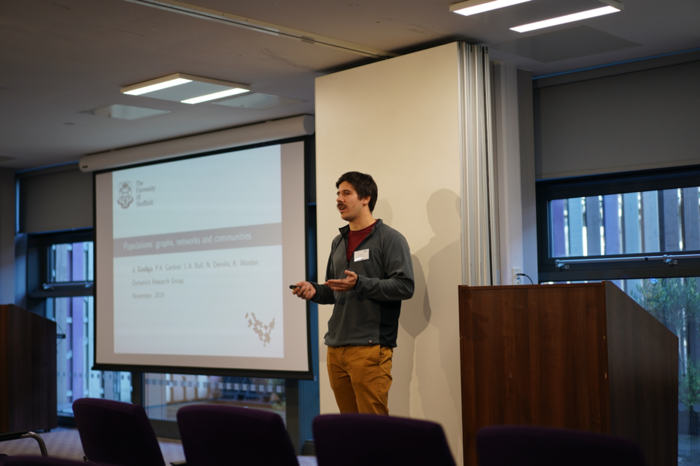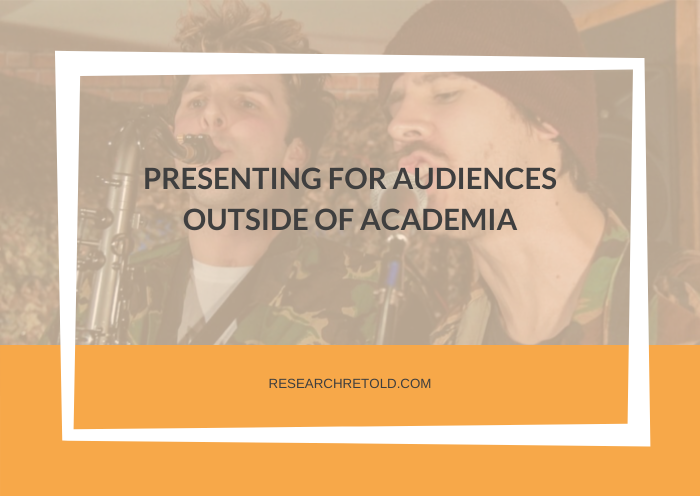In this blog post, Julian Gosliga discusses the topic of presenting for audiences outside of academia.
Julian is a Research Associate in the Department of Mechanical Engineering at the University of Sheffield. In his current role and during his PhD, Julian has regularly been involved in communicating his research to the public.
Specifically, his research examines ways to create and compare abstract (graph) representations of engineering structures to improve the availability of structural health monitoring data.
Julian was a participant in our ‘Communicating Research Beyond Academia’ workshop in June 2020. He ‘enjoyed having focused time to think and discuss how and why I’m explaining my research to a non-academic audience.’
We are keen to learn more from Julian’s tips and insights in this blog.
Why do we struggle to engage audiences outside of academia?

As academics, we learn to present during our undergraduate course, through our PhDs, and (hopefully) we carry on learning as we present at conferences and meetings. But, throughout this time, we tend to only present to other academics!
Therefore, on the rare occasion we’re confronted with a non-academic, what do we do? We use the only presentation style we’ve learnt, and it’s not one that necessarily works to engage non-academic audiences.
Some people can naturally adapt their presentation style, but for most of us, it requires a bit of thought. However, time spent thinking about how you can effectively engage your audience is time well spent. If you want to influence policymakers, persuade industrial partners to fund your project, or even inspire the next generation of researchers you need to learn to effectively engage your audience.
In this post, I share three main steps to help you prepare for presenting to audiences outside academia.
Below I discuss the content, visuals and delivery of your presentation.
Presenting for audiences outside of academia
Step 1. Content: think about your message and your audience

The first step to engaging your audience is to ask yourself: who is my audience? In doing so, remember that you are an academic – they are not. While you might enjoy seeing pages of detailed analysis, they might not be as keen.
This leads to the next question: what do they want from my presentation? You can normally work this out by thinking about why they are attending your presentation. By doing this you can ensure you keep your audience engaged and give them value for attending your presentation.
It is also important to figure out what you want them to get from your presentation. This then becomes your key message. You can work this out by asking yourself: why am I doing this presentation? This way you can be confident that your presentation achieves the goal you originally had in mind.
To make sure that nothing gets lost in translation, it can be useful to consider any differences in technical knowledge or background. These questions can be very useful:
What information do they need from me to understand my message?
What other barriers could prevent them from understanding what I have to say?

An example of this was when I delivered a Pint of Science presentation on my current research. For conferences, I could simply state that the application was ‘structural health monitoring’ and people would know what I meant.
Yet, for this presentation, I had to not only explain what structural health monitoring is but how it was even possible to detect damage in structures using vibration signals.
To make it interesting and relatable, I thought it was important to use tangible examples. I chose an example of vibration that most people are familiar with: instruments. By using a familiar example, I was able to explain how changes in the vibration of a structure can indicate damage. This taught them something new (which kept the audience interested) and laid the foundation for them to understand my specific research area.
Step 2. Visuals: choose an appropriate visual style

If you have answered the previous questions, the overall content of your presentation should be suitable for your audience. However, different audiences are used to and will therefore prefer different visual styles of presentation.
People from industry will prefer a more business-like visual with clear facts and figures. The general public might prefer simple graphics to illustrate points. Pupils may prefer a lesson-style approach with bullet points for key pieces of information.
While they may understand what you’re saying, people will be more receptive to your message if your presentation appeals to them visually. A familiar visual style can help your audience feel more confident and comfortable with what you are saying, especially when you are presenting new ideas and information.
Here’s how you can present the same idea in two different ways for two different audiences…
Academic audience (conference presentation)
The first image is from a conference presentation. Note the technical language and detailed figures. Moreover, the figures are abstract. The academic audience is familiar with the concept and has more interest in how it has been applied.

General public (public science/tech interest event)
For the general public, it was important to illustrate the abstract figures with a real-life image of a wind turbine. The figures are simplified and the explanations on the image are clear.

Finally, note that the conference presentation also contains information about the university the presenter belongs to and their email. This is most useful to include since a conference presentation is also an invitation to collaborate/network.
Step 3. Delivery: present in a way that engages

By now you should have a presentation with a suitable message and visual style that will be well received by your audience. Clearly, the topic is important enough that you have put the time in to study it. You have now also put in the time to carefully craft a presentation in order to disseminate your findings. The way you present should reflect this. Why would you give a lacklustre presentation about something that you have so much interest in?
It’s quite easy to see presenting simply as something to get out of the way. This might work at academic conferences where the audience has a strong intrinsic motivation to understand what you are saying despite your presentation.
We’ve all seen it where someone has presented their work with their back to the audience, mumbling as they read off the slides. A non-academic audience will go to sleep if you do this. Yet, as academics, we can often infer from the title of the presentation, that it must contain important ideas and so we force ourselves to stay awake.
A non-academic audience often comes in with a neutral attitude, waiting for you to sell them on a particular topic. They are not familiar with the topic and if you don’t seem interested, they will assume that they shouldn’t be interested either.
People will judge your level of interest by your body language rather than what you are saying. If you make eye contact with your audience, speak loudly and clearly (practice projecting), and use hand gestures, people will be interested in what you are saying.


‘Every presentation is a performance.’ – Douglas Curran-Everett
One of the things that really helped me hone my presentation style was joining a band. Clearly, this isn’t an option for everyone, but it helped me to see presentations as a performance. I wasn’t there to simply relay information in a monotone voice, I was there to engage an audience.
There is of course the situation where you are passionate about your work and really would sell it to the world, if only you weren’t so nervous. Nerves show that the outcome of a given presentation matters to you (and so it is definitely a presentation worth doing). When used correctly, nerves can give you more energy while you present.
However, we can also become overwhelmed by nerves. This tends to happen when we are not used to feeling nervous and the only way to truly get over it is to practice. If you present at every opportunity, you will soon become used to the usual cycles of nerves, presentation, and relief.
Conclusion
When presenting for audiences outside of academia, keep in mind that there are many styles of presentation. Part of presenting to different audiences is not only choosing the appropriate content but also tailoring your presentation style to suit their needs/expectations. Of course, the final ingredient to an effective presentation is how you deliver it.
Choose the message that you want to get across, and that you can explain clearly to your audience. Make sure that you present the information using a visual style and content that will aid your audience’s understanding. And finally, make sure your enthusiasm for your chosen topic comes across in the way that you present.
In general, practising presenting will help you to not only feel more confident when presenting for audiences outside of academia, and teach you to use any nerves to your advantage. Practising presenting to different audiences will also benefit your academic presentations by giving you a greater overall awareness of how you present.
Thank you
Many thanks to Julian Gosliga (@JulianGosliga) for sharing his experience and tips on presenting for audiences outside of academia. Please comment below with your own tips.
If you enjoyed this post, you may enjoy reading presenting research to a non-academic audience, presenting sensitive information in creative ways or creative methods of research dissemination.
